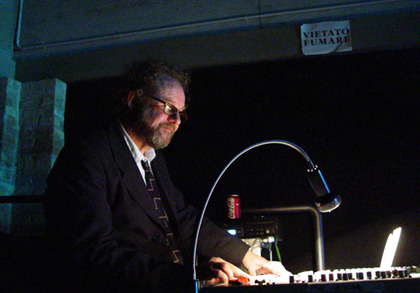Review
Timecode live: quartet for four cameras

Mike Figgis remixing Timecode. Photo courtesy the artist.
Daniel Trilling sees Mike Figgis perform a live show-and-tell remix of his digital 2000 split-screen experiment ‘Timecode’
Kings Place, London, UK
15 September 2010
The British-born Mike Figgis is one of Hollywood’s great nonconformists, having smuggled radical ideas about form and technique into mainstream cinema over the course of a career that has produced box-office hits such as Leaving Las Vegas (1995) and Internal Affairs (1990). This is perhaps most evident in Timecode (2000), which Figgis shot on digital cameras in four long, simultaneous takes, played back together on a screen split into quarters. The film’s fluid, improvised drama (a tale of adultery set among the dregs of the Los Angeles movie business) was a subtle and darkly humorous critique of the failings of conventional screen story-telling.
A ‘live mix’ of Timecode was the opening event in four nights of screenings and concerts at Kings Place, curated by Figgis, who has a background as a jazz musician. The film was played back through a laptop, with Figgis controlling not only the speed and direction of play, but manipulating separate audio tracks that contained dialogue, music and sound effects.
Timecode’s real innovation, Figgis explained as he introduced the film, came in the way it was written. He divided a sheet of paper into 98 bars, each one representing a minute of screen time. With basic characters in mind, Figgis sketched out a story based on the principles of musical composition. “What a string quartet does is exactly what I was trying to do. A quartet begins with a theme, then it’s repeated by another instrument, for example in a minor key.”
Figgis told the audience that one of the main benefits of continuous, synchronised performance (which took feats of ingenuity from cast and crew: the film had to be shot 15 times over to find a useable version) was that it increased the power for dramatic irony. He emphasised this in the live mix by rewinding key sequences and playing them back so we could hear the sounds coming from a different part of the screen. He also tried to show how different sounds coloured our perceptions of the action. A snippet from Mahler’s Fifth Symphony, often used as Hollywood shorthand for profound sadness, was played while people milled around aimlessly; the sound of a character chewing gum noisily was faded in during a sex scene. On occasion it felt somewhat laboured, but then the variations had to be obvious: how many of us who watched Timecode on its release a decade ago could remember what it sounded like the first time around?
Like Timecode itself, the live mix was interesting not so much for the immediate results, but the questions it raised. Why should the creative process stop when a film leaves post-production? Is it possible to perform a film? Could viewers control the mix and negotiate their own way through a story? There is a political element to this, too. Digital technology has already significantly eroded the status of recorded music as an easily-controlled commodity and Figgis gave us a glimpse of what might lie ahead if it were to happen to film on a similar scale.
See also
Miss Julie reviewed by Peter Matthews (October 2000)
Timecode reviewed by Xan Brooks (Film of the Month, September 2000)
The Loss of Sexual Innocence reviewed by Charlotte O’Sullivan (December 1999)
The Winslow Boy reviewed by Geoffrey Macnab (November 1999)
Wilful amateur: Mike Figgis talks to Geoffrey Macnab about The Loss of Sexual Innocence (May 1999)
Russian Ark: one of Sight & Sound’s 30 key films of the 2000s (February 2010)
